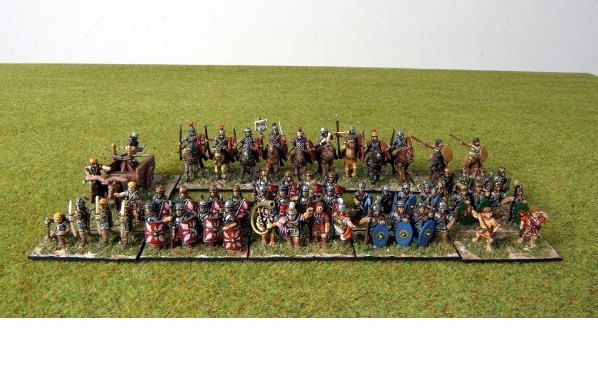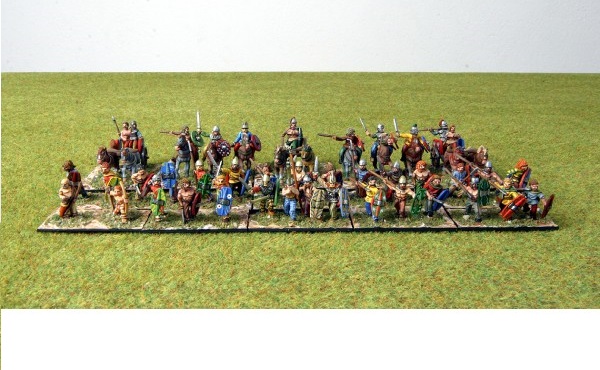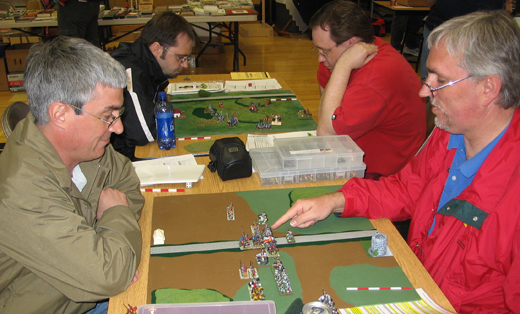
We delve into DBA and find out what it is and how it is played.
What is DBA?
De Bellis Antiquitatis (DBA) is a set of fast play rules (simple to remember and easy to learn but hard to master) for ancient and medieval wargaming using miniature figures. The authors of the rules are Phil Barker, Sue Barker and Richard Bodley Scott. DBA covers a period of time from 3000 BC to 1500 AD and the rulebook gives you access to around 300 army lists from those periods.
The first thing that will strike you about DBA is that each army is composed of 12 units (called elements) and only 12, regardless of faction or period of time. Yes, the first objections are probably going to be raised by the gamers that want to differentiate between low quality high number armies and elite but low in number forces. Well, that’s not the point of DBA. The whole system does not go towards that thinking as Spear units for Romans are exactly the same as Spear units for Gauls (for example). Where DBA wants to put its mark is the match-up between different versions of units. So the armies are all created equal in number of units however what those units actually are is going to drastically influence how they play.

Units are composed of 2 to 4 figures mounted on a 40mm width bases with various depths: 15mm, 20mm, 30mm and 40mm. While a unit of spears might be represented by 4 spearmen mounted on a 40×20 base a unit of elephants will be represented by an elephant mounted on a 40×40 base. You are wondering what does this actually mean? Well, it’s easy! It means you’ll have between 30 to 50 miniatures to paint for a whole army, which in itself is a very good news.
The second good news is that a battle lasts typically between 20 to 40 minutes. Like we said above, DBA is a set of fast play rules. The interest is to keep the actual rules to a minimum and focus on the tactics involved in the fighting which to my mind this game does achieve spectacularly.
The rules (basing and movement scales) are designed primarily for use with 15mm or 25mm figures and the scale is 1″ to 100 paces (for 15mm or smaller forces). Looking around 15mm armies are quite easy to find, cheap to boot and, you guessed it, you can buy them directly from us!

Troop types in the game are basically the foot troops: Auxilia, Blades, Bow, Horde, Pike, Psiloi (skirmishers), Spear and Warband and the mounted troops: Camels, Cavalry, Elephants, Chariots, Knights, Light horse and special units such as Artillery and War Wagons. No distinction is made between Roman Blades and Gaullic Blades or British Cavalry and Roman Cavalry however each unit relates to different types of units in a different way. For example Knights are good to run down most foot troops however they get killed quite easily from Bow shooting. Pikes are good against heavy infantry however they suffer when fighting against light infantry. Elephants kill cavalry easily however skirmishers will deal with them very effectively. So basically it is a game of chess where you want to engage the good match-up to your units and prevent the enemy forcing his good match-ups on you.

Short description of the game turns
General overview of how a game is played
1. The game is played by two players on a square board (24″ by 24″ however 30″ by 30″ is recommended for 15mm) with terrain pieces added. Each player has an army of 12 units which are determined according to the army list that the player selected.
2. Both players roll a die and add the army aggression factor to the number to determine which is Defender (low score) and which is Invader (high score) as explained in “Deployment” section of “Fighting the Battle”.
3. The player who becomes the Defender chooses terrain based on its army’s topography (listed for each army in the army lists) and places it on the board as explained in “Creating the Battlefield”.
4. The invader numbers 3 of board edges 1 – 2 – 3 (one of which is the side with a Built Up Area, if any) and numbers the side most preferred 4-5-6 (one with no BUA). The invader then rolls a dice and the number that comes up is the Invader’s side , the one opposite is the defender’s side. Turn the board so each player has the appropriate side in fornt.
5. The Defender places a camp on the board on its side, if needed, and then the invader does the same.
6. The defender then places units on the board within the area described in “Deployment” and then the Invader places his units.
7. The defender can then switch the positions of up to 2 pairs of units on the table as described in the “Deployment” section.
8. The Invader gets the first chance to move. This is the first turn of the game. The player first rolls a die; the number obtained is the number of “PIPs” for tactical moves as explained in the “Player Initiative Point Dicing” section of “Fighting the Battle.” PIPs are not needed for shooting or combat and cannot be saved from bound to bound. They are used only for tactical movement.
9. The invader moves elements or groups of elements as explained in the appropriate sections of “Fighting the Battle.” Units can move forward, laterally, they can enter different formations or they can retreat.
10. After that movement, both sides carry out shooting as explained in the “Distant Shooting” section. The Invader, since it is the first bound, chooses, in turn, which unit of either side is to shoot, but not the targets nor supporting units. Outcomes occur as explained in the “Resolving Shooting or Close Combat” and Combat Outcome” sections. Some units might chose to retreat or run due to a successful ranged attack on them.
11. Both sides then carry out close combat according to the “Close Combat” section and outcomes occur. The Invader chooses the order of combat. The combats are selected one at a time; all need not be specified at the beginning of the combat phase. This is arguably the most important phase of the game (aside from movement) where it will matter if your Spears are fighting Cavalry (which they can beat) or if they fight Blades (which will probably rout them).
12. If game is not over as explained in the “Winning and Losing,” the Defender takes a turn and events follow as for Invader, with the defender rolling a die for PIPs, moving, choosing the order of shooting and combat for both sides . If victory conditions are not met, the cycle back and forth between Invader and Defender, until victory conditions are achieved by one player. The game then ends. An equal number of turns for each player is not required.
The victory conditions are:
Kill the enemy general or kill 4 enemy units and
Lose less units then your enemy
There’s not much else i can say except: See you on the battlefield!

Leave a Reply